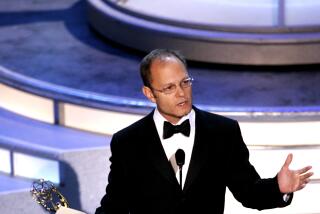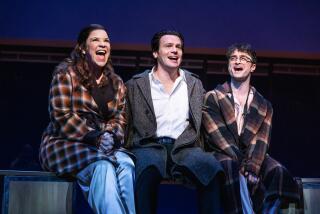David Wayne, 81; Versatile Actor Won 2 Tony Awards
- Share via
David Wayne, whose Broadway, TV and film portrayals ran a gamut of characters ranging from a scientist trying to save the world to an ingenuous Asian bent on bringing happiness to GIs in a far-off land, is dead.
A daughter, Melinda, said Friday that her father had died Thursday after a lengthy struggle with lung cancer. He was 81.
Winner of two Tony awards and nominated for an Emmy, the actor fit comfortably into lead and character roles in films and television, whether they were musicals, comedies or dramas.
Born Wayne David McKeekan in Traverse City, Mich., he majored in business administration at Western Michigan College while also appearing in several college plays.
In 1936, Wayne joined a Shakespearean repertory company in Cleveland, where Sam Wanamaker and Arthur Kennedy also made their theatrical beginnings.
He teamed with a touring marionette company and then came to Broadway, where he labored through a long and largely fallow apprenticeship before World War II.
In the early days of the war he drove an ambulance in Africa for the British. After the United States joined the war he served with the U.S. Army.
In 1947, two years after he was discharged, he landed the role that was to prove the sine qua non of his career.
It was as the leprechaun in the Irish fantasy “Finian’s Rainbow,” and its magical musical moments and satire brought him his first Tony.
Next he introduced the world to everyone’s favorite military innocent, Frank Thurlowe Pulver, the precocious ensign in “Mr. Roberts” in 1948. It was as Pulver that he first appeared opposite Henry Fonda with a crew haircut, a style that remained his signature for many years.
Though Wayne’s first Tony took him more than two decades, his second came more quickly.
He won again in 1954, this time as best actor in “The Teahouse of the August Moon,” where he portrayed Sakini the clever Okinawan bent on melding cultures. He co-starred with John Forsythe and the play won that year’s Pulitzer Prize for drama and the Drama Critics’ Circle award.
After his success in “Mister Roberts,” he was invited to Hollywood for parts in two highly touted films, “Portrait of Jennie” and “Adam’s Rib,” both in 1949.
His motion picture roles proved as varied a blend as his stage work, from a small-town barber who ages 56 years in the 1951 film “Wait Till the Sun Shines, Nellie,” to impresario Sol Hurok in “Tonight We Sing” (1953).
He was the duke in a 1974 remake of “Huckleberry Finn,” Dr. Dutton trying to find a cure for the “Andromeda Strain” in 1974, the landlord in “How to Marry a Millionaire” (1953) and the insensitive husband in “The Three Faces of Eve” (1957).
Among his other better known pictures were “The Last Angry Man,” “The Front Page,” “The Apple Dumpling Gang” and “The Survivalist.”
Wayne starred in the TV series “Pearson Norby” in 1955, was Inspector Richard Queen in “The Adventures of Ellery Queen” in 1975-76 and as Willard (Digger) Barnes on “Dallas” in 1978.
In 1957 Wayne was nominated for an Emmy for an appearance in the “Heartbeat” episode of “Suspicion,” a suspense anthology.
And devotees of the Caped Crusader and Boy Wonder could occasionally see Wayne as the Mad Hatter, a “Batman” nemesis in 1966-67.
In 1960, he and Edward G. Robinson had starred in what many critics felt was a TV landmark, “The Devil and Daniel Webster.”
His daughter said he continued to do TV movies and a few smaller films into the early 1990s but “generally just retired.”
Years ago, Wayne told a studio biographer he was happiest on the stage but like any other actor could not resist a good script “regardless of the commute.”
His wife of 52 years, onetime actress Jane Gordon, died in 1993.
In addition to Melinda, he is survived by another daughter, Susan Kearney, and two grandchildren. The family asks contributions in his name to AIDS Project Los Angeles.
More to Read
The biggest entertainment stories
Get our big stories about Hollywood, film, television, music, arts, culture and more right in your inbox as soon as they publish.
You may occasionally receive promotional content from the Los Angeles Times.










